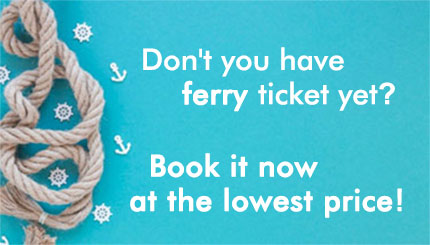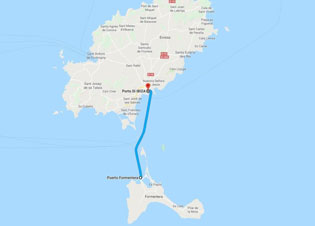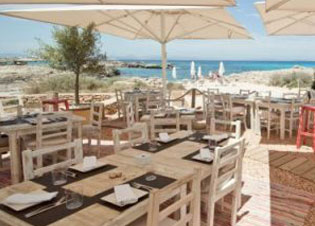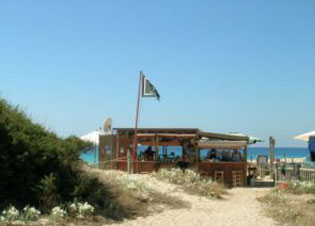
Formentera, the last paradise of the Mediterranean.
Where is Formentera?
Formentera is an island in Spain and belongs to the Balearic archipelago, which also consists of the islands of Mallorca, Menorca, and Ibiza. With its area of only 83 km², it is the smallest of all and is located south of Ibiza, precisely 2 nautical miles away (about 3 km). Formentera does not have an airport and is only accessible by sea.
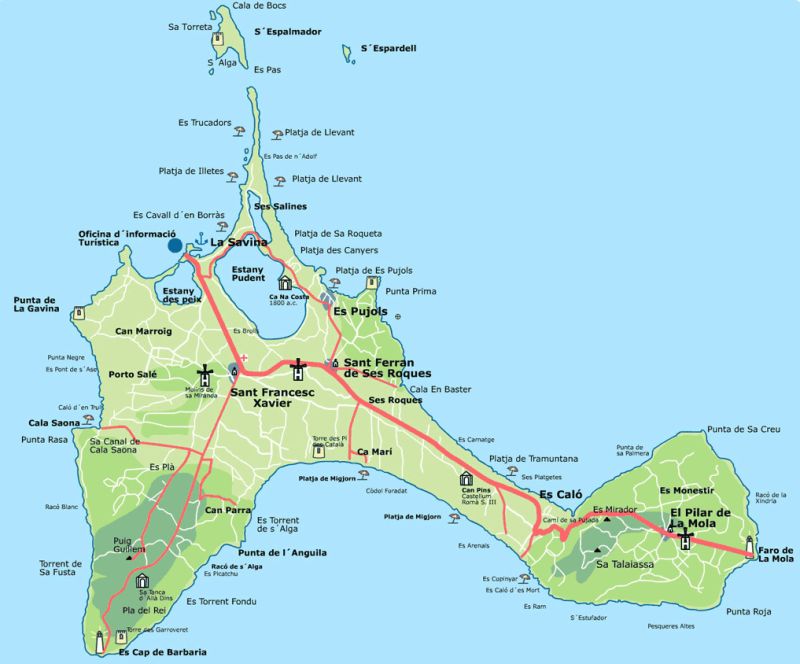
Formentera map
To get to Formentera you will have to take a flight to Ibiza, go to the port which is about 10 minutes by taxi from the airport and take a ferry that will take you to Formentera in just 30 minutes, precisely in the town of La Savina (the only port on the island). From there you can go in a short time to the other towns or to its wonderful beaches.
Geography
Despite its small size, only 19 km long, Formentera has a long coastline (69 km) and the presence of numerous beaches, coves and enchanting places will soon make you forget about stress and everyday problems.
Thanks to its mainly flat nature, in the less hot months, we recommend renting a bicycle, the ideal way to get in tune with the genius loci of the place. In fact, there are numerous green routes to explore: you will be completely enveloped by the scent of pines, junipers and the numerous aromatic plants that grow spontaneously in this magical place. It is also easy to come across numerous species of birds such as flamingos and seagulls, or other animals such as lizards (symbol of the island) and hedgehogs. Flora and fauna are preserved by the Consell Insular de Formentera.
However, the use of bicycles is recommended only during the day, as in the evening the dirt roads and poor lighting make them unsuitable for this data-cfasync="false" data-cfasync="false" type of vehicle (it is better to opt for motorcycles or cars).
Located at the two ends of the island and at a higher altitude are the lighthouses of Cap de Barbaria and La Mola. The first is located to the southwest, after a few kilometers of unspoiled nature, and the other is located to the east, at about 200 meters above sea level, at the end of the village of El Pilar de la Mola. To reach them, it is necessary to rent a scooter or a car.
In general, the island still retains a rural appearance, especially in the less beaten areas: in fact, the typical local constructions survive, the farms and the characteristic dry stone walls of millennial tradition. As you can see, the residential architecture provided for large houses built with stones from the island, with very thick walls capable of protecting from the winter cold and the summer heat. It is not uncommon to see, adjacent to these houses, even external wells and ovens, used by families who provided for their personal water and food needs independently.
The dry stone walls still serve as boundaries to delimit the various plots of land, but also to prevent animals from entering the busiest roads. Today, local and non-local workers are specialized in this data-cfasync="false" data-cfasync="false" type of construction, which is also very popular in newly built houses.
Within the island there is a main road, the PM820, which connects the two ends: 19 km long, it starts from the port of La Savina and reaches the lighthouse of La Mola. From this road, numerous secondary roads lead to the various localities and beaches of Formentera. To get your bearings, know that each place along this stretch of road is identified by the kilometer it belongs to (calculated based on the distance from the port of La Savina).
The population currently stands at 11,171 inhabitants (January 2024 data from the Formentera registry office), which shows a slight decrease compared to 2023, when there were 11,418 residents. The island itself has a relatively recent history of settlement, considering that at the beginning of the 1900s there were about 2,000 inhabitants. Like many other places, the island has a good percentage of foreigners, around 33% in 2023, including many Italians, while 41% come from other parts of Spain.
The salt flats of Formentera, located not far from the port of La Savina and now in disuse, have been part of a nature reserve since 1995. This area boasts a high ecological richness thanks to a unique ecosystem. In the northern part of the island there is a lagoon called Estany Pudent. It has an area of 3.5 km², reaches a depth of 4 meters in the central part and belongs to the Natural Park of the Salinas. The name Pudent (stinky in Catalan) derives from the bad smell that emanates during hot summer days. A strange phenomenon that can be observed there, on windy days, is the flakes of salty foam that accumulate near the shore: this derives from the high salinity of the waters.
Not far away there is a second, much smaller lagoon, called Estany des Peix. It has an outlet to the sea, called Sa Boca, which is about 50 meters long.
Climate
The climate is Mediterranean, with dry summers, mild winters, and little rainfall during the summer months. The highest probability of rain is in the months of January, February, and March. The small size of the island and the almost complete absence of mountains mean that the climatic characteristics vary very little from one place to another.
Sunny days are a constant in summer, but they are also frequent during the other seasons. The sea water is warm in the months of July, August, and September with a temperature equal to or greater than 24 degrees. Slightly cooler in the months of June and October.
Tourist Destination
The island of Formentera stands out for its great environmental beauty, but what undoubtedly makes it famous worldwide is the transparency of its waters. The secret of Formentera’s long beaches and crystal-clear sea lies in the meadows of Posidonia oceanica that surround the island. This aquatic plant, very similar in structure to terrestrial ones, has fundamental ecological importance: it constitutes the climax community of the Mediterranean Sea and protects the coasts from erosion. Its presence is a good indicator of coastal marine waters. For this reason it was declared a World Heritage Site by UNESCO in 1999.
In the past, agriculture, pastoralism, fishing and salt extraction were the main fields of sustenance for the local economy. Only from the seventies onwards did the natives move their business towards the tourism sector, creating hospitality and reception facilities. The first people to discover the island were mainly of German and French nationality.
From then on, visitors arrived from all over Europe and the economy changed radically. Even today, tourism-related activities are the most developed and profitable for most of the native population. The tourist season usually starts with Easter week and ends at the end of October.
In recent years, what has made the island even more famous is the presence of numerous celebrities: Lionel Messi, Cristiano Ronaldo, Cara Delevingne, Noel Gallagher, Usain Bolt, Giorgio Armani, Nico Rosberg and Kate Moss are just a few names that choose the island for their holidays every year.
Villages
The villages of Formentera are all small in size and each has different characteristics. Es Pujols is the tourist center par excellence, there are numerous holiday homes, hotels, bars and restaurants. Very lively in summer, it remains practically uninhabited from the end of October until the beginning of the new tourist season.
La Savina is home to the port and is a very lively place during the day due to the constant coming and going of people arriving and departing. In addition to the scheduled ferries that connect the island to Ibiza, there is an area where private boats are moored.
Completely different are the towns of Sant Francesc Xavier, Sant Ferran and La Mola. The first is the island’s capital, home to institutional activities and inhabited by the islanders. During the summer it fills up with tourists but its identity does not change from season to season. Here you can get in touch with the local population who love to linger in the bars overlooking the church. Its maze of narrow streets lined with whitewashed houses makes Sant Francesc one of the most authentic and admired villages in Formentera.
Sant Ferran is a smaller town with a strong sense of community. Many locals live there and there are also some schools. In summer it is especially popular in the evenings thanks to its characteristic craft market and numerous restaurants. The small church overlooking the square is very intimate.
La Mola, on the other hand, is a more isolated location and is characterized by the vast wooded area that surrounds it. Here too there is a small church with a cemetery nearby. It is known to tourists for the large hippy market that takes place in the square every Wednesday and Sunday during the high season.
Beaches
The beaches of Formentera are mostly sandy, but in some places you can also find rocks. Among the most famous are undoubtedly Ses Illetes and Llevant, in the northern part of the island. Often included in the ranking of the most beautiful beaches in Europe, they fascinate for their wild and unspoiled nature.
Es Pujols is instead the only town to have a small town center and a wonderful beach that stretches for about 700 meters. Very crowded in the months of July and August, it is the beach with the most services in absolute: sunbeds and umbrellas available, as well as a considerable number of bars and restaurants on the waterfront.
Migjorn beach stretches along the entire southern side of the island. You can access it from the area called Cà Marì to the last section where the wonderful Caló des Mort is located. Predominantly sandy, it is also rich in coves and rocky inlets. Very popular with naturists, it is the ideal place for those seeking an oasis of peace. One of the most evocative stretches of sea is located at km 11.
On the opposite side, the small beaches of Es Caló develop, a tiny town famous for being home to numerous “escars”, or shelters for the boats of local fishermen. These inlets are characterized by having a part of fine and clear beach mixed with rock that continues towards the sea.
Cala Saona is instead a beach located on the western side of the island. Crescent-shaped, it is set between high red cliffs. Thanks to its position, it is one of the best places to watch the sunset.
Lighthouses
There are a total of three lighthouses on Formentera, but only two are the ones that all tourists go to see. The La Mola lighthouse is located in the town of the same name and stands on cliffs that reach 192 meters above sea level. Since 2019, the lighthouse has housed a multidisciplinary space and a museum of great interest for the island’s maritime heritage. The spectacular views offered by this place make it one of the most photographed.
The Cap de Barbaria lighthouse is located to the west, not far from Cala Saona. To reach it, you have to leave your vehicle at the end of an asphalt road that can only be reached on foot. It is a suggestive walk of less than two kilometers that will lead you directly to the foot of the imposing lighthouse. The barren and rocky terrain that houses it is somewhat reminiscent of the lunar surface.
The small La Savina lighthouse, at the port, is the one that can be observed once you arrive on Formentera or when you are about to leave the island.
Craft markets
The craft markets of Formentera represent the island’s hippy heritage. In the 1960s, in fact, many young revolutionaries in search of a simple and genuine lifestyle chose Formentera as their new home. Far from the prevailing consumerism, here one could still live in contact with Mother Nature; suffice it to say that, at the time, electricity was not yet widespread in all the inhabited centers.
The most famous market is undoubtedly the one that takes place every Wednesday and Sunday, from 4 to 10 pm, in the village of La Mola. Full of stalls and with a decidedly hippy atmosphere, it is one of the most loved and frequented by tourists.
Based on the sale of works of art such as drawings, paintings, and handcrafted creations is the small Sant Ferran market, which takes place every day of the week, except Wednesday and Sunday, in the pedestrian street.
More commercial, but always very scenic, is the market that takes place on the Es Pujols promenade. Every evening you will find a river of tourists trying to make room to admire the stalls. You will find everything and it will be difficult to resist the temptation to buy something.
Dedicated to the sale of jewelry is the market in Sant Francesc, active every morning until about 2 pm. The charming stalls, scattered along the streets of the center, offer handmade objects strictly by the island’s artists.
Near the port of La Savina there is a market open from morning until late evening. You can find everything there and it is very popular with those looking for a small gift before leaving for home.
YOU MAY ALSO LIKE:
“Every trip you live three times:
when you dream it,
when you live it
and when you remember it. “
PROMOTIONAL CODE
Book online using the promotional code ESTATE123 and save with our partners. The code is valid for EVERYONE. You can take advantage of the discounts even if we were unable to provide the right accommodation for you.



